Attila Kertesz-Farkas about New Lab and Research

Laboratory on AI for Computational Biology has opened at the Faculty not so long ago. We talked with its head, Attila Kertesz-Farkas, about the lab, research and his way in science.
My background is computer science; I’ve been researching for nearly two decades. I started with speech recognition and natural language processing methods twenty years ago, but then shortly I switched to bioinformatics because I thought that the Hungarian language is impossible to process. Since then, for fifteen years, I’ve been developing machine learning and data mining methods for bioinformatics.
After getting PhD in Hungary, I had a one-year-long research position in the US for the Food and Drug Administration, University of Maryland, Baltimore County. Then I moved to Italy, where I have been working and studying mass spectrometry data analyzing. After that, I returned to the US, where I was offered a postdoctoral senior researcher position at the University of Washington which is consistently ranked among the top-20 university around the world. I was amazed how the research was organized there: I was surprised how everything was pragmatic and aimed at solving real problems that could accelerate the research fast and efficiently. Everything seemed to be focused on practical questions and doing things that are working. After the US, my wife (who is Russian) and I considered coming back to Russia or Hungary. At this point, I got an offer from HSE University, so we came to Russia in 2015 and have been here since then.
In the lab, we analyze mass spectrometry data. Mass spectrometry is used to identify organic molecules in a complex sample. For example, to identify proteins in a blood sample. Cancerous and normal cells are also sampled to find certain chemicals present in some and absent in others. This method can be used in drug therapy to establish an efficient treatment. There are also forensic applications; for example, fire accelerants can be found at the site to determine if the fire so that the arson can be discovered. Pesticides can be found in soil, hormones in animals, bacteria in potable water — all through mass spectrometry.
Our goal is twofold: first, to annotate data to understand what molecule generates the given mass spectrum; second, to develop statistical methods to prove that a given annotation is correct. Our main intent is to improve the methods of analysis, making them more statistically viable.
Now we are in the process of establishing our laboratory. It includes finding people and putting them on projects and also obtaining necessary funds. We have some open positions: we are looking for a C++ developer to implement our methods through open-source toolkits so that our methods are available to the scientific community. In the long term, we plan to extend the scope to analyze different types of data.
